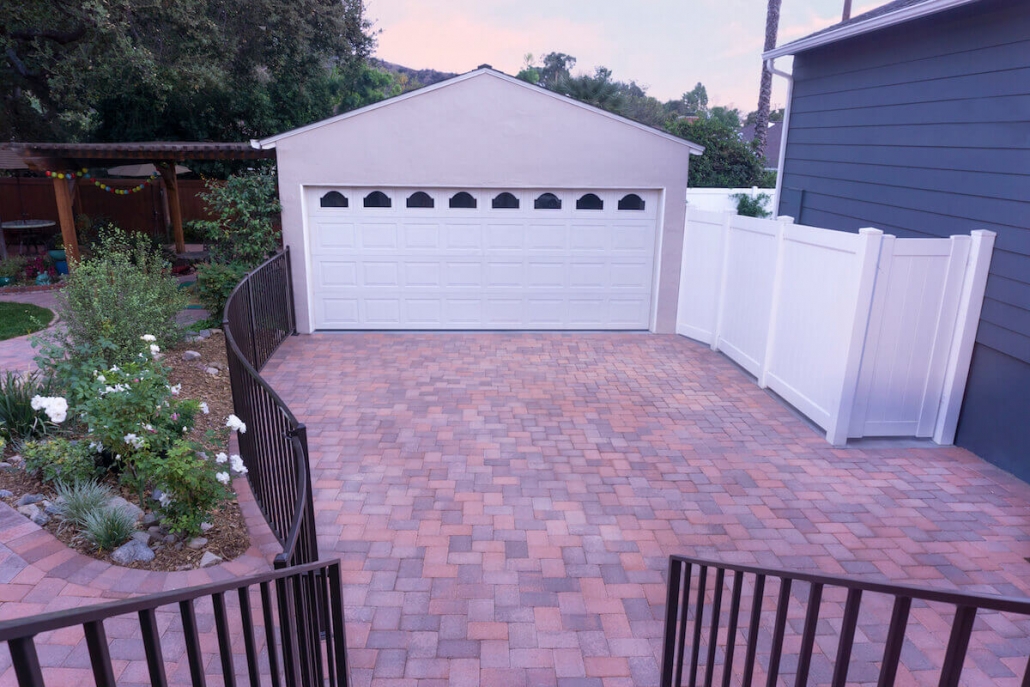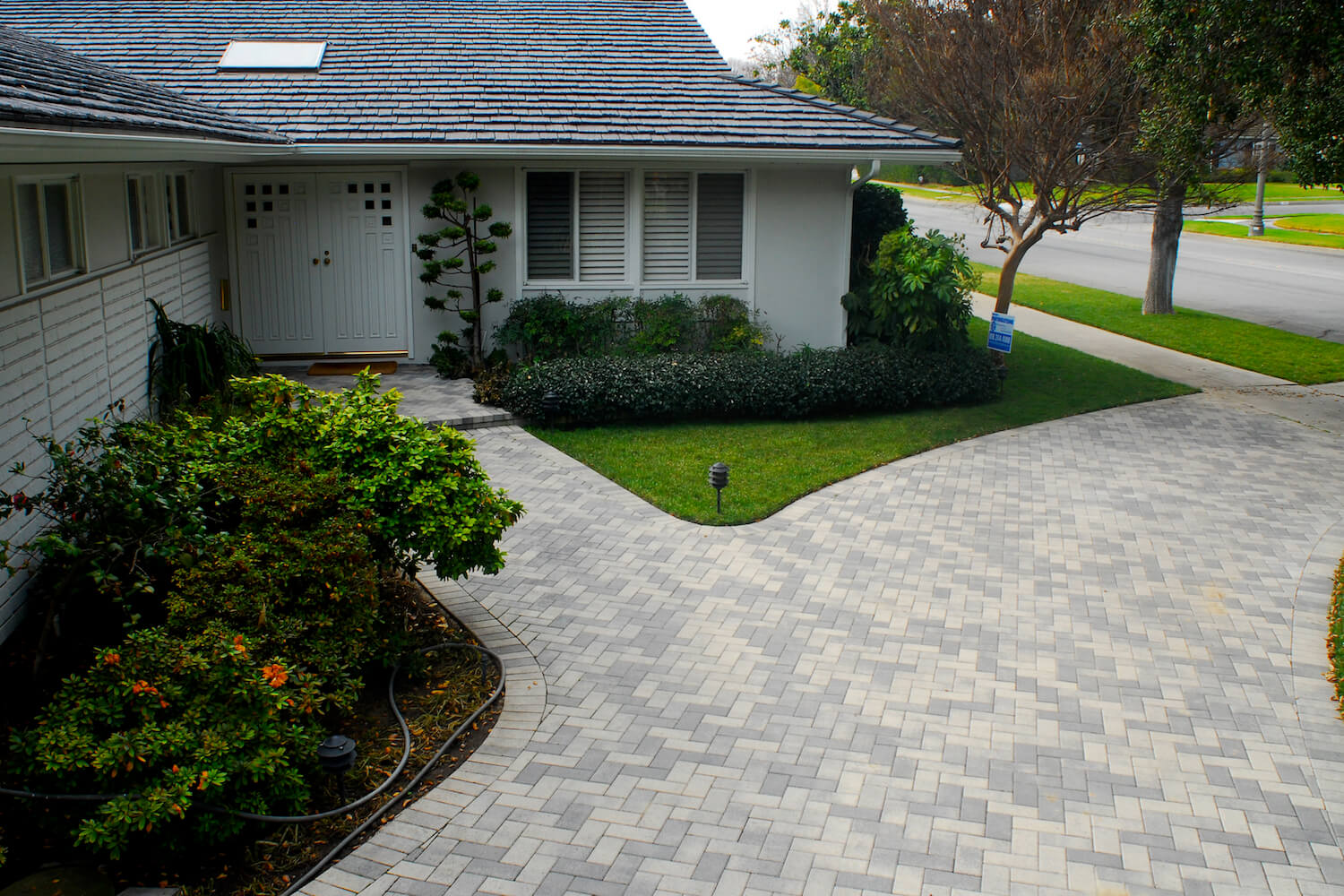Paving stone driveways are a popular choice for not only their classy appearance but also the reduced maintenance they provide compared to asphalt or concrete.
Even if you choose to have a landscaping company or paving contractor install pavers, there could come a point when your driveway may experience unwanted stains. Removing stains on pavers is possible in most circumstances if you follow these helpful tips.
How to Remove Stains on Pavers

Manufactured concrete pavers are similar to many other driveway, patio, or walkway materials in one respect. Their surface is porous and can easily absorb stains. Even if protective measures are taken and sealants are applied to their surface, paver stains and typical dirt deposits can happen even with the best care.
Paving stones can be removed and replaced as a last resort, making them far superior to asphalt or concrete. However, before replacement is considered, try removing stains on pavers with these general guidelines and specific strategies.
General Guidelines for Removing Stains on Pavers

We’ll get to specific remedies for removing stains on pavers in a moment, but here are some general guidelines to follow.
- Manufacturers have the best guidelines for specific stains. Ask your contractor if their are any resources they can direct you to on how to remove stains on pavers.
- Before you try any specific method, try to find the most inconspicuous area of your driveway to test the cleaning agent’s end result. Always read the instructions on cleaning materials. Follow the instructions exactly for mixing, application, personal protective gear, and first aid in the event of an accident.
- Thoroughly rinse areas after applying materials to paver stains. Try to wash materials away from plants if possible. If this is not possible, try to dilute the solution with as much water as possible.
- If you’re trying to remove oil stains on pavers, use a granular absorbing material (resembles kitty litter). Much of the spill can be absorbed this way versus rubbing it into the paver. Rubbing could make the problem worse.
- Use soft, nylon bristled brushes that won’t scratch pavers. If a pressure washer is used at some point, understand that this can dislodge the polymeric sand in paver joints that enables them to interlock. Some new sand could need to be added when the surface thoroughly dries.
Specific Recommendations for Removing Stains on Pavers

Paver manufacturers may slightly vary with recommendations depending upon the stain and specific product used for your driveway, walkway, or patio. However, these are some common, specific tips for removing stains on pavers.
Removing Oil Stains on Pavers
Oils of many sources may stain pavers. The most common source can be oil dripping from a vehicle parked on a paving stone driveway. However, oil and grease deposits can be commonly found on paver patios near a grill or outdoor kitchen.
- Keep some paper towels, rags, and a bucket of granular oil-absorbent material handy in garages or outdoor kitchens.
- If oil or grease is freshly deposited, lightly blot (not rub) the areas with a clean rag or paper towels. Liquid dish soap or laundry detergent will remove most oil stains on pavers. Directly apply the soap to the stain and allow to sit for 20-30 minutes. Then scrub with a nylon bristle brush and rinse with hot water. Repeat this step as needed.
- If removing oil stains on pavers after the material has dried and absorbed, soak up as much oil on pavers as possible. Leave granular materials on areas for approximately 6 hours. Sweep up the material. Follow the instructions above for freshly deposited stains.
Removing Hard Water Stains on Pavers A.K.A Efflorescence
Most of what people refer to as water stains on pavers is actually a natural process called efflorescence. Pavers begin to exhibit a powder-like deposit, most commonly in the first couple years after installation.
Efflorescence is caused when the soluble salt salts in the pavers react with rainfall, humidity and temperatures fluctuating. As the water evaporates, the salts come to the surface, creating a whitish appearance.
If you wish to speed up nature’s cleaning process, most paver manufacturers offer an Efflorescence Remover. This cleaner can be somewhat abrasive, so be sure to test an inconspicuous area first, and then clean the entire paver surface.
Removing Rust Stains on Pavers
If steel or iron items sit on or above paver areas for a period of time, you may end up with rust stains on pavers. As rusting metal drips onto these areas, particularly over a long period of time, removing rust stains on pavers becomes very difficult.
Removing rust stains on pavers requires a material that can damage sealers that may have been previously applied. This material may also cause some surface etching on pavers so you may want to apply the material to the entire paver area surface for uniform look. Test a small area first and consult with a paving stone contractor if needed.
If possible, remove rusting metals from these areas. However, if cleaning is needed, paver manufacturers often offer rust remover materials. Apply the material according its label’s directions. Scrub the area with a soft, nylon bristle brush and rinse thoroughly.
Successful Stain Removal on Pavers

The best defense against stains on pavers is regular inspection. The longer a contaminant sits on a paving stone, the greater the potential for staining. Make it part of your routine to inspect these areas weekly.
Clean the areas thoroughly a few times a year, before typical dirt can settle in. Talk to a reputable paving stone installer to discuss any options for adding sealants to these areas for added protection against stains on pavers.
Remember that one of the best features of pavers over other surface materials is that if you can still remove a stained section and replace them with new paving stones. This is less conspicuous the newer your surface is.